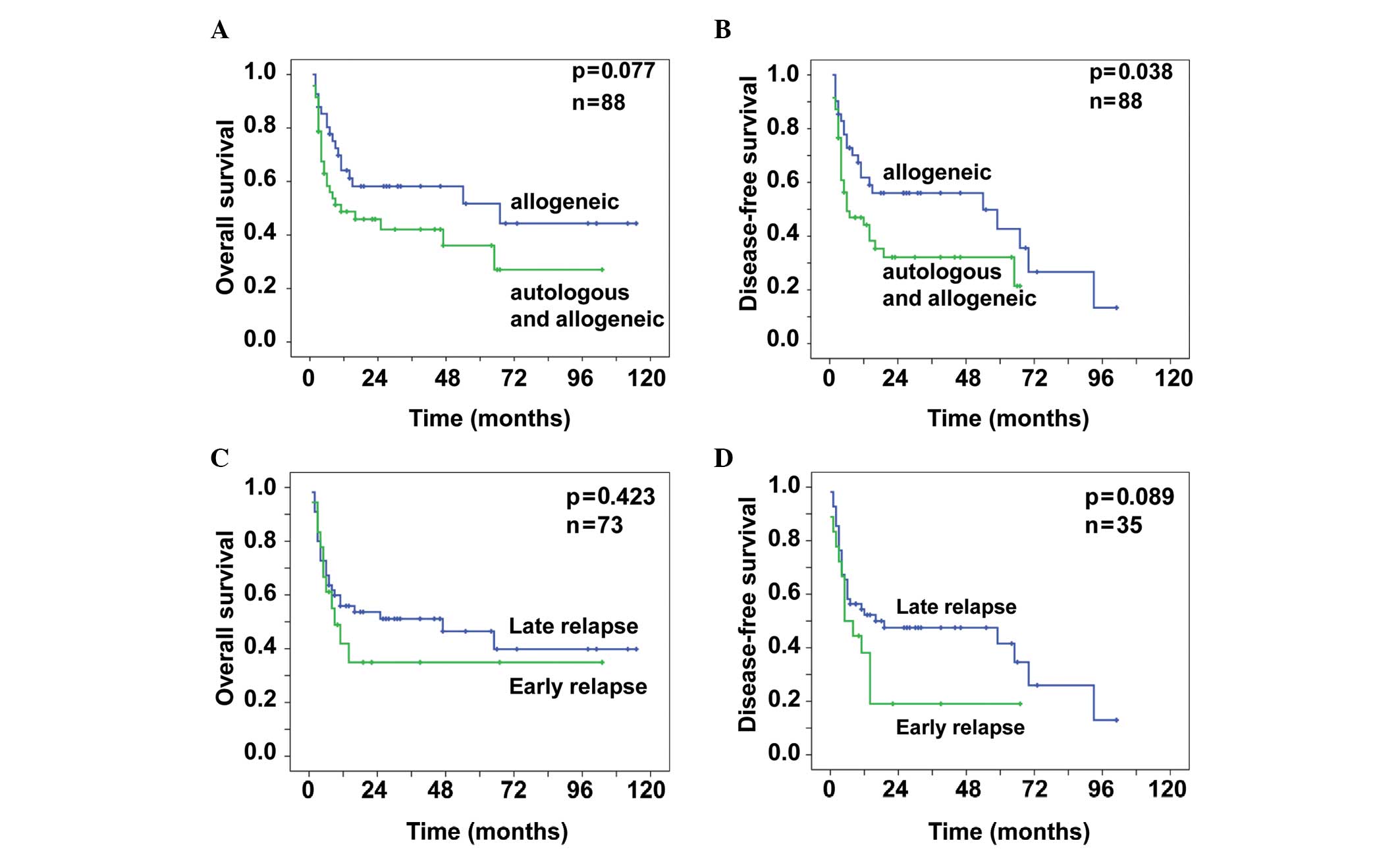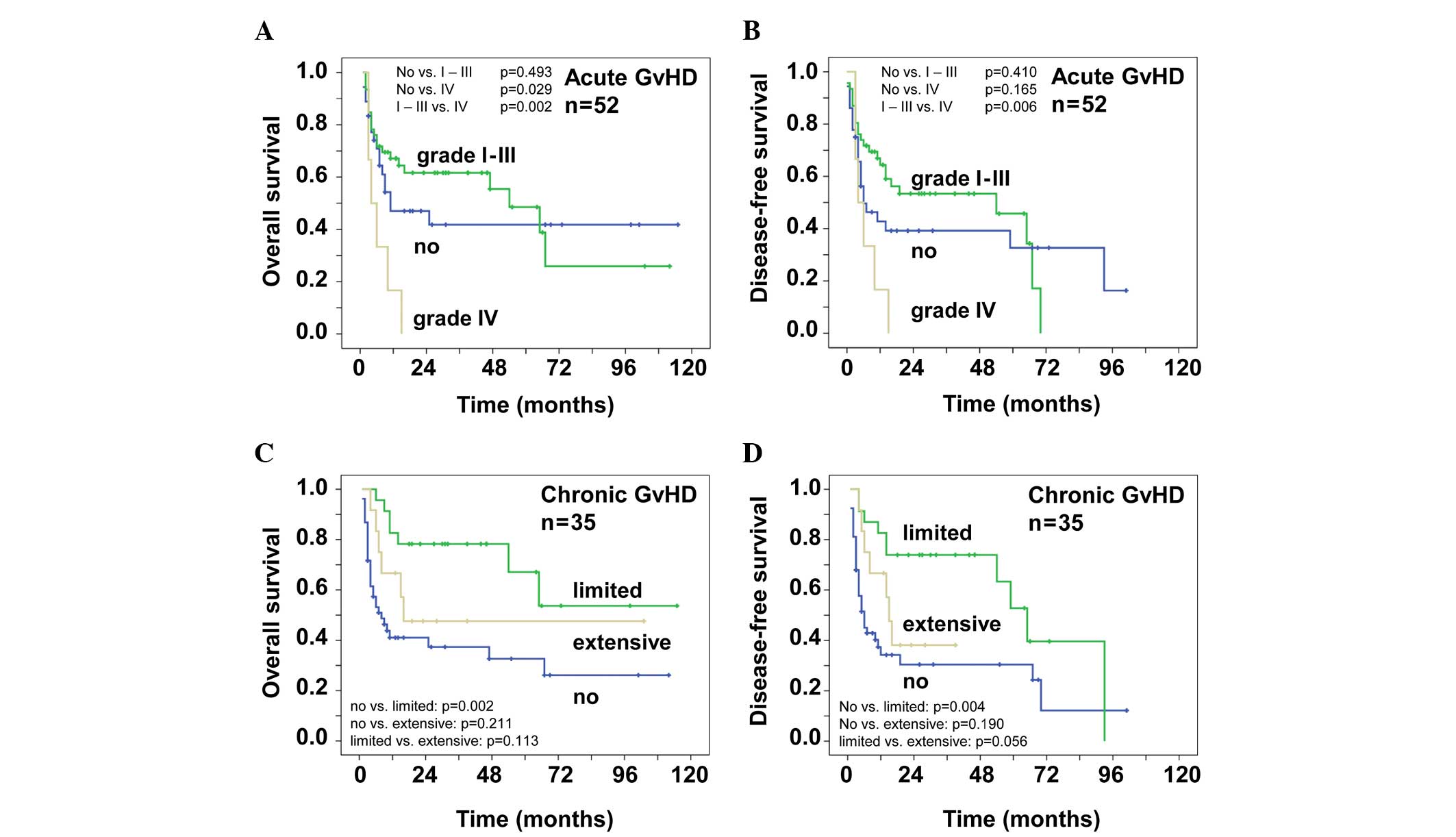|
1
|
Verdonck LF, van Putten WL, Hagenbeek A,
et al: Comparison of CHOP chemotherapy with autologous bone marrow
transplantation for slowly responding patients with aggressive
non-Hodgkin’s lymphoma. N Engl J Med. 332:1045–1051.
1995.PubMed/NCBI
|
|
2
|
Chen AI, McMillan A, Negrin RS, et al:
Long-term results of autologous hematopoietic cell transplantation
for peripheral T cell lymphoma: the Stanford experience. Biol Blood
Marrow Transplant. 14:741–747. 2008. View Article : Google Scholar : PubMed/NCBI
|
|
3
|
Hamadani M, Benson DM Jr, Lin TS, et al:
High-dose therapy and autologous stem cell transplantation for
follicular lymphoma undergoing transformation to diffuse large
B-cell lymphoma. Eur J Haematol. 81:425–431. 2008. View Article : Google Scholar : PubMed/NCBI
|
|
4
|
Koenigsmann M, Casper J, Kahl C, et al:
Risk-adapted, treosulfan-based therapy with auto- and allo-SCT for
relapsed/refractory aggressive NHL: a prospective phase-II trial.
Bone Marrow Transplant. 49:410–415. 2014. View Article : Google Scholar : PubMed/NCBI
|
|
5
|
Bishop MR, Dean RM, Steinberg SM, et al:
Correlation of pretransplant and early post-transplant response
assessment with outcomes after reduced-intensity allogeneic
hematopoietic stem cell transplantation for non-Hodgkin’s lymphoma.
Cancer. 116:852–862. 2010.PubMed/NCBI
|
|
6
|
Hamadani M, Benson DM Jr, Hofmeister CC,
et al: Allogeneic stem cell transplantation for patients with
relapsed chemorefractory aggressive non-Hodgkin lymphomas. Biol
Blood Marrow Transplant. 15:547–553. 2009. View Article : Google Scholar : PubMed/NCBI
|
|
7
|
Casper J, Knauf W, Kiefer T, et al:
Treosulfan and fludarabine: a new toxicity-reduced conditioning
regimen for allogeneic hematopoietic stem cell transplantation.
Blood. 103:725–731. 2004. View Article : Google Scholar : PubMed/NCBI
|
|
8
|
Schmidt-Hieber M, Blau IW, Trenschel R, et
al: Reduced-toxicity conditioning with fludarabine and treosulfan
prior to allogeneic stem cell transplantation in multiple myeloma.
Bone Marrow Transplant. 39:389–396. 2007. View Article : Google Scholar : PubMed/NCBI
|
|
9
|
Casper J, Wolff D, Knauf W, et al:
Allogeneic hematopoietic stem-cell transplantation in patients with
hematologic malignancies after dose-escalated
treosulfan/fludarabine conditioning. J Clin Oncol. 28:3344–3351.
2010. View Article : Google Scholar
|
|
10
|
Hilgendorf I, Wolff D, Gromke T, et al:
Retrospective analysis of treosulfan-based conditioning in
comparison with standard conditioning in patients with
myelodysplastic syndrome. Bone Marrow Transplant. 46:502–509. 2011.
View Article : Google Scholar : PubMed/NCBI
|
|
11
|
Cheson BD, Horning SJ, Coiffier B, et al:
Report of an international workshop to standardize response
criteria for non-Hodgkin’s lymphomas. NCI Sponsored International
Working Group. J Clin Oncol. 17:12441999.PubMed/NCBI
|
|
12
|
Cutler C and Antin JH: Manifestations and
treatment of acute graft-versus-host disease. Thomas’ Hematopoetic
Cell Transplantation. Appelbaum FR, Forman SJ, Negrin RS and Blume
KG: 4th edition. Willey-Blackwell; London: pp. 1287–1303. 2009
|
|
13
|
Lee SJ, Vogelsang G and Flowers ME:
Chronic graft-versus-host disease. Biol Blood Marrow Transplant.
9:215–233. 2003. View Article : Google Scholar : PubMed/NCBI
|
|
14
|
El Gnaoui T, Dupuis J, Belhadj K, et al:
Rituximab, gemcitabine and oxaliplatin: an effective salvage
regimen for patients with relapsed or refractory B-cell lymphoma
not candidates for high-dose therapy. Ann Oncol. 18:1363–1368.
2007.PubMed/NCBI
|
|
15
|
Martin A, Conde E, Arnan M, et al;
GEL/TAMO Cooperative Group. R-ESHAP as salvage therapy for patients
with relapsed or refractory diffuse large B-cell lymphoma: the
influence of prior exposure to rituximab on outcome. A GEL/TAMO
study. Haematologica. 93:1829–1836. 2008. View Article : Google Scholar : PubMed/NCBI
|
|
16
|
Le Gouill S, Milpied N, Buzyn A, et al:
Société Française de Greffe de Moëlle et de Thérapie Cellulaire:
Graft-versus-lymphoma effect for aggressive T-cell lymphomas in
adults: a study by the Societé Française de Greffe de Moëlle et de
Thérapie Cellulaire. J Clin Oncol. 26:2264–2271. 2008.
|
|
17
|
Khouri IF, McLaughlin P, Saliba RM, et al:
Eight-year experience with allogeneic stem cell transplantation for
relapsed follicular lymphoma after nonmyeloablative conditioning
with fludarabine, cyclophosphamide, and rituximab. Blood.
111:5530–5536. 2008.
|
|
18
|
Dietrich S, Tielesch B, Rieger M, et al:
Patterns and outcome of relapse after autologous stem cell
transplantation for mantle cell lymphoma. Cancer. 117:1901–1910.
2011. View Article : Google Scholar : PubMed/NCBI
|
|
19
|
Chopra R, Goldstone AH, Pearce R, et al:
Autologous versus allogeneic bone marrow transplantation for
non-Hodgkin’s lymphoma: a case-controlled analysis of the European
Bone Marrow Transplant Group Registry data. J Clin Oncol.
10:1690–1695. 1992.
|
|
20
|
Peniket AJ, Ruiz de Elvira MC, Taghipour
G, et al: European Bone Marrow Transplantation (EBMT) Lymphoma
Registry: An EBMT registry matched study of allogeneic stem cell
transplants for lymphoma: allogeneic transplantation is associated
with a lower relapse rate but a higher procedure-related mortality
rate than autologous transplantation. Bone Marrow Transplant.
31:667–678. 2003.
|
|
21
|
Bierman PJ, Sweetenham JW, Loberiza FR, et
al: Lymphoma Working Committee of the International Bone Marrow
Transplant Registry and the European Group for Blood and Marrow
Transplantation: Syngeneic hematopoietic stem-cell transplantation
for non-Hodgkin’s lymphoma: a comparison with allogeneic and
autologous transplantation - The Lymphoma Working Committee of the
International Bone Marrow Transplant Registry and the European
Group for Blood and Marrow Transplantation. J Clin Oncol.
21:3744–3753. 2003.PubMed/NCBI
|
|
22
|
McSweeney PA, Niederweiser D, Shizuru JA,
et al: Hemapoietic cell transplantation in older patients with
hematologic malignancies: replacing high-dose cytotoxic therapy
with graft-versus-tumor effects. Blood. 97:3390–3400. 2001.
View Article : Google Scholar : PubMed/NCBI
|
|
23
|
Khouri IF, Saliba RM, Giralt SA, et al:
Nonablative allogeneic hematopoietic transplantation as adoptive
immunotherapy for indolent lymphoma: low incidence of toxicity,
acute graft-versus-host disease, and treatment-related mortality.
Blood. 98:3595–3599. 2001. View Article : Google Scholar
|
|
24
|
Escalon MP, Champlin RE, Saliba RM, et al:
Nonmyeloablative allogeneic hematopoietic transplantation: a
promising salvage therapy for patients with non-Hodgkin’s lymphoma
whose disease has failed a prior autologous transplantation. J Clin
Oncol. 22:2419–2423. 2004.PubMed/NCBI
|
|
25
|
Rezvani AR, Storer B, Maris M, et al:
Nonmyeloablative allogeneic hematopoietic cell transplantation in
relapsed, refractory, and transformed indolent non-Hodgkin’s
lymphoma. J Clin Oncol. 26:211–217. 2008.PubMed/NCBI
|
|
26
|
Glass B, Nickelsen M, Dreger P, et al:
Reduced-intensity conditioning prior to allogeneic transplantation
of hematopoietic stem cells: the need for T cells early after
transplantation to induce a graft-versus-lymphoma effect. Bone
Marrow Transplant. 34:391–397. 2004. View Article : Google Scholar
|
|
27
|
Beelen DW, Trenschel R, Casper J, et al:
Dose-escalated treosulphan in combination with cyclophosphamide as
a new preparative regimen for allogeneic hematopoietic stem cell
transplantation in patients with an increased risk for
regimen-related complications. Bone Marrow Transplant. 35:233–241.
2005. View Article : Google Scholar
|
|
28
|
Scheulen ME, Hilger RA, Oberhoff C, et al:
Clinical phase I dose escalation and pharmacokinetic study of
high-dose chemotherapy with treosulfan and autologous peripheral
blood stem cell transplantation in patients with advanced
malignancies. Clin Cancer Res. 6:4209–4216. 2000.
|
|
29
|
Banna GL, Aversa S, Sileni VC, et al:
Nonmyeloablative allogeneic stem cell transplantation (NST) after
truly nonmyeloablative and reduced intensity conditioning regimens.
Crit Rev Oncol Hematol. 51:171–189. 2004. View Article : Google Scholar
|
|
30
|
Schetelig J, Bornhauser M, Kiehl M, et al:
Reduced-intensity conditioning with busulfan and fludarabine with
or without antithymocyte globulin in HLA-identical sibling
tranplantation - a retrospective analysis. Bone Marrow Transplant.
33:483–490. 2004. View Article : Google Scholar
|
|
31
|
Slavin S, Nagler A, Naparstek E, et al:
Nonmyeloablative stem cell transplantation and cell therapy as an
alternative to conventional bone marrow transplantation with lethal
cytoreduction for the treatment of malignant and nonmalignant
hematologic diseases. Blood. 91:756–763. 1998.
|
|
32
|
Robinson SP, Goldstone AH, Mackinnon S, et
al: Lymphoma Working Party of the European Group for Blood and Bone
Marrow Transplantation: Chemoresistant or aggressive lymphoma
predicts for a poor outcome following reduced-intensity allogeneic
progenitor cell transplantation: an analysis from the Lymphoma
Working Party of the European Group for Blood and Bone Marrow
Transplantation. Blood. 100:4310–4316. 2002.
|
















